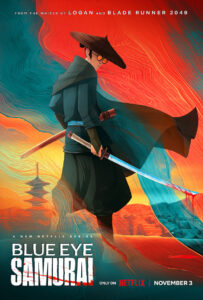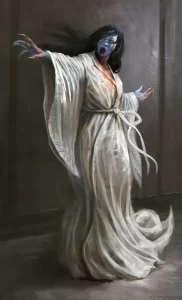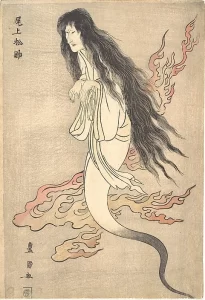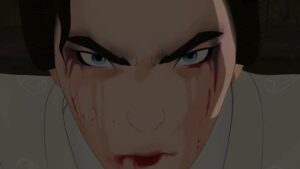In the shadows of Japanese folklore, an entity stirs, embodying the essence of vengeance and the unresolved anguish of the departed. This figure, known as Onryō, has recently captured the imagination of audiences worldwide through Netflix’s latest sensation, “Blue Eyed Samurai“. Here, the protagonist’s journey mirrors the chilling path of an Onryō, invoking both awe and fear. But what exactly is an Onryō?
A Demon Waging War On Patriarchy and Prejudice
We had not watched a production for a long time that successfully took us away from our reality and transported us to other worlds. Netflix’s latest marvel, Blue Eye Samurai, has accomplished this admirably. Created by Amber Noizumi and Michael Green, centers on the revenge journey of a female samurai. Lookingwho is forced to hide her ethnic origin and gender identity. In a recipe that includes a pinch of Mulan and a piece of Kill Bill is already good enough to reach cult status.

The main character, Mizu, is cursed with blue eyes in the rural Japan of the 1600s. The incidence of blue eyes among Japanese is extremely low; it’s almost non-existent. While blue eyes may be admired for their uniqueness in Western cultures, in Japan, they are seen as a symbol of abnormality. In fact, in Japanese folklore, they are sometimes even associated with a type of demon; Onryō.
What Is The Meaning of Onry?

At its core, Onryō refers to a type of yūrei (ghost) in Japanese folklore. They distinguished by their quest for vengeance. Unlike other spirits, an Onryō’s wrath stems from intense feelings of anger and betrayal experienced during their lifetime. These emotions are so potent that they transcend death. Hence, granting the spirit power to affect the physical world. Often, their rage is directed towards those who wronged them. Or sometimes, it manifests as a general malevolence towards the living.
The Birth of the Onryō Myth
The concept of Onryō is deeply rooted in Japanese history and cultural beliefs. The beginnings of the Onryō concept are somewhat ambiguous, yet historical documents dating to Japan’s late Yamato period in the 7th or 8th century hint at its origins. This era, notable for the introduction of Buddhism to Japan, bears a significant resemblance to the Onryō myth, particularly in its similarity to the concept of ‘hungry ghosts’ in Buddhism, or ‘Preta’ in Sanskrit.

This spirit of revenge emerges when an individual is murdered, betrayed or compelled to die. Consumed by intense fury against those responsible for their death or betrayal, the deceased person becomes an Onryō. A blue eyed demon, relentlessly pursuing vengeance.
One of the earliest and most famous Onryō stories is that of Lady Rokujo from “The Tale of Genji”. A classic work of Japanese literature from the early 11th century. Lady Rokujo, consumed by jealousy and heartache. She becomes an Onryō after her death, haunting and tormenting her romantic rival.
Blue Eye Samurai and the Onryō: A Modern Take on Ancient Female Spirits
At first glance, the Onryō might seem like any other ghost story, a typical mythological character from Japanese culture. Indeed, all mysterious female characters entwined in ancient languages appear so. This is because each women character in each story, reflects the woman of its time. The trials women have faced through the ages, what they could not become, and what they are actually capable of, are hidden in these stories. After all, the ordeal of an ordinary woman is profound enough to inspire tales for generations. This perspective is essential when looking at the story of Onryō too.

The spirit of the woman who returns for revenge after death is thirsty for retribution for the pain she suffered in life. And why shouldn’t it be? Consider what builds up inside a person who, throughout their life, is never asked for their opinion, pushed aside, physically oppressed, treated like property, bought and sold, whose sole aim in life is “to make a good marriage,” and whose motto is not to speak unless necessary. In society, a woman has no name. Therefore, the best option for her might be to carve her name and her hatred into the minds of all people as a demon.
Netflix’s Blue Eye Samurai do a great reading on Onryō. The standout episode, “The Tale of Ronin and the Bride,” shows us why our protagonist, Mizu, chose her path. The series wonderfully answers what a woman, who opens her heart despite all the wounds and fears inside, is capable of when she is betrayed, an Onryō.
